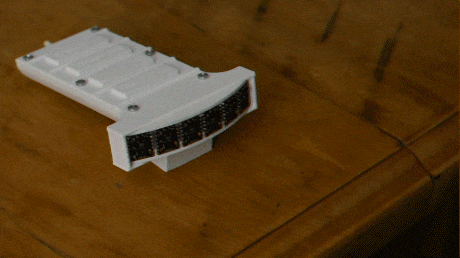This year, [Blecky’s] Hackaday Prize Entry is an air guitar which uses multiple LiDAR sensors to create the virtual strings. What’s also neat is that he’s using his own LiDAR sensor, the MappyDot Plus, an enhanced version of his 2017 Prize Entry, the MappyDot.
 He uses a very clever arrangement of six sensors to get four virtual strings. Each sensor scans a 25-degree field of view. Three adjacent sensors are used to define a string, with the string being in the overlap of the outer two of those sensors. The middle sensor is used for the distance data.
He uses a very clever arrangement of six sensors to get four virtual strings. Each sensor scans a 25-degree field of view. Three adjacent sensors are used to define a string, with the string being in the overlap of the outer two of those sensors. The middle sensor is used for the distance data.
For the chords, he started out using some commercially made joysticks but ran into some ergonomic issues. Also, the manufacturer was discontinuing the product, a no-no for an open source project. So he abandoned that approach and designed his own buttons. He came up with a PCB with a linear hall effect sensor and some springs on it. The button has a magnet attached to its underside and sits on the springs. That way he gets the press and can do vibrato as well.
He plans to use Bluetooth MIDI so that you can play the sound on a phone or laptop but for now he lights up an LED beside each sensor as you press the strings.


















Love it. Looks fun. I’ll put it on my list to make.
Without the ability to know exactly when you hit the string, feel how strong you activated each string or even interact with the vibrating string after you activated it, this feels more like 1980’s era IR based video game controllers that were strongly hyped but barely worked at all for, well, actually playing games with.
This really feels like it is unlikely to work with enough clarity, bandwidth and real time feedback to actually have the guitar do what you wanted it to do in the hands of an experienced operator.
It’s a neat idea but you arguably lose the full effect of the original instrument so this winds up being novel but no where near equal to playing a stringed instrument in the first place.
https://www.youtube.com/watch?v=BfP9RKflSJM
Here is a harp version example. There are several others out there as well.
here’s a thought: portability… hard to fit a guitar in your pocket…
Not as hard as you might think. This is their third version.
https://www.youtube.com/watch?v=b76jqfVCYC8
There are also foldable ones but this is more of a MIDI controller with actual physical feedback.
One of the goals of the project is to also get velocity and after strum expression on the strings. Vibrato is also achievable with the linear hall effect buttons.
It’s one of the reasons I have gone with the sensor array as it is, instead of just a single sensor per string, because you do get some of that additional information before the strum is activated in the target area with minimal latency. At the moment the overall string detection latency including the sensor measurement time is 12ms (the sensors run at 100Hz each), however this doesn’t include Bluetooth and software processing delays which add a bit (it supports USB MIDI as well).
It would definitely not compete with the real instrument, but the main focus of the project was originally to create something that is reasonably easy to pick up even by beginners, is fun to play, is somewhat modular (take the sensor array and stick it on something else) and could be used in a more advanced ways as well (rather than just be a toy/neat demo).
The project certainly has merit and is definitely interesting. Just looking at ways to improve things such that it more accurately represents playing a traditional guitar.